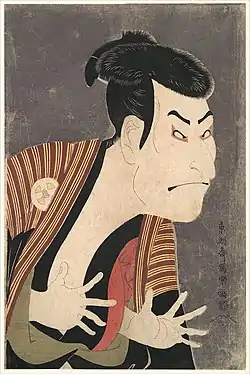
Egoyomi (盲暦) is a Japanese picture calendar, in which the length and order of the months are deducible, like a code, from cryptic markings that are incomprehensible to most people but transparent to enthusiasts.[1] These type of calendars thrived during the so-called Meiwa era of the late 18th century. This was a period when it was prohibited to make unofficial calendars. Since these kinds of calendars were illegal, it has been claimed that calendar markings that would have indicated the purpose of these pictures as a calendar, were not included. However, the extent to which these pictures misled the authorities is a topic of debate.[1][2]
These calendar woodblock prints were surimono, privately commissioned and published works not intended for the general public but used within private circles. Eventually, the same pictures reached the public market: the calendar information was carved off the wooden blocks, which were then reprinted and sold.[3]
See also
References
- 1 2 Simon-Oikawa, Marianne (30 October 2008). "Le temps codé : les calendriers en images (egoyomi) au Japon". Extrême-Orient, Extrême-Occident (30): 145–173. doi:10.4000/extremeorient.102. Retrieved 17 September 2022.
- ↑ "Egoyomi: Picture Calendars for the New Year". Artic.edu. Retrieved 16 September 2022.
- ↑ Hockley, Allen; Isoda, Koryūsai (2003). The prints of Isoda Koryūsai : floating world culture and its consumers in eighteenth-century Japan. University of Washington Press. p. 58. ISBN 9780295983011. Retrieved 17 September 2022.
Further reading
- Forrer, Matthi (1979). Egoyomi and surimono : their history and development. J.C. Gieben. ISBN 9789070265014. Retrieved 17 September 2022.
External links
![]() Media related to Egoyomi at Wikimedia Commons
Media related to Egoyomi at Wikimedia Commons
